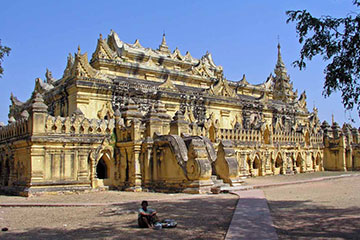
Inwa or Ava, located just 20 km southwest of Mandalay Region, Burma (Myanmar), is an ancient imperial capital of successive Burmese kingdoms for nearly 400 years from the 14th to 19th centuries. Inwa was also known as Yadana Pura. It was first founded as a capital by King Thado Minbya in 1364 A.D. As successive kings ruled the war with King Raza Darit of Bago for many years, the Shan chief Thohan Bwa took the advantage and overran the capital. Gradually the kingdom grew weaker and finally it became a vassal to the Taungoo Empire. Later kings shifted the capital from Inwa back and forth many times until King Bayint Naung’s son King Nyaung Yan re-established his capital at Inwa in 1596 A.D. It continued to be capital till 1782 when Bodawpaya moved the capital to Amarapura. But his son King Bagyidaw moved his capital back to Inwa. The capital city was finally abandoned after it was completely destroyed by a series of major earthquakes in March 1839. Though only a few traces of its former grandeur remain today, the former capital is a popular day-trip tourist destination from Mandalay.
The name Inwa literally means “mouth of the Lake”, reflecting its geographical location at the mouth of lakes in the Kyaukse District. Another theory states that it is derived from Innawa, meaning “nine lakes” in the area. The city’s classical name in Pali is Ratanapura (“City of Gems”).
Inwa was identified as the seat of power in Burma that Inwa (as the Kingdom of Ava, or the Court of Ava) was the name by which Burma was known to Europeans down to the 19th century.
The Maha Aung Mye Bonzan, well known as Me Nu Oak-kyaung (Brick Monastery), was built in 1822 by Nanmadaw Me Nu, Chief Queen of King Bagyidaw, for the royal abbot Nyaunggan Sayardaw U Po, who then offered to the 2nd Nyaunggan Sayardaw U Bok. It was also damaged by the earthquake of 1838 but was repaired in 1873 by Sinphyumashin, the daughter of Me Nu and a queen of King Mindon. This monastery is one of the finest specimens of Myanmar architecture during the Konbaung Period (19th century). Its architecture is in simulation of wooden monasteries with multiple roofs and a prayer hall of seven-tiered superstructure.
The name Bargaya is a Mon word. It literally means Khayebin Kyaung. The Bagaya monastery was built on the southwest of Inwa palace on 1593. During Hsin Phyu Shin's reign (1763-1776) Atwinwun Mahathirijeyathankhya, town officer of Magwe built the monastery in the Bagaya monastic establishment and dedicated to Shin Dhammabhinanda. During King Bagyidaw (1819-1837) the great fire broke out to Kontha quarter. to the south of the palace on 15 April 1821 and Hluttaw. tooth relic tower. watch tower and to northern gate caught fire and seemed that the Bagaya monastery was burnt in the fire. The government tried to reconstruct in 1992. It intends to build a (gadhakuti) special shrine for the use of Buddha image and Pitaka scriptures. So it put the new Brick building in the place of the old monastery. It was recorded that the monastery was constructed on the model of the old monastery. The grand Bagaya monastery, decorated with splendid Myanma architectural works, is in the ancient city of Innwa. King Bagyidaw of Innwa era built the Bagaya monastery at the confluence of the Ayeyawady and the Myitnge rivers in 1196 Myanma Era.
The watch tower which is about 90 feet (30 m) high is a solitary masonry building that remains of Bagyidaw's palace built in 1822. Owing to the earthquake of 1838, only the lower part was left but it was restored as its original structure. The watch tower is one of the examples of Myanmar architectural style of early 19th century. Inwa is famous for its watch tower which is also known as leaning tower of Ava, the Bagayar Monastery.

Myanmar Interlink Services Travel & Tour @2025.Developed by Digital Dots
